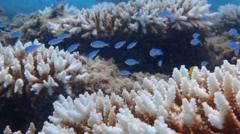World-renowned coral reefs in Western Australia (WA) are undergoing their most severe bleaching episode ever recorded, driven by the state's longest and most intense marine heatwave, according to scientists. This troubling phenomenon occurred between August of last year and May, when elevated water temperatures inflicted extreme heat stress on the reefs, prompting coral to expel the algae responsible for their vibrant colors and essential for their survival—a process known as bleaching, which is frequently fatal.
The devastation, which will take months to evaluate fully, stretches across an astonishing 1,500km (932 miles), affecting regions previously sheltered from the impacts of climate change. The global coral bleaching crisis, triggered by unprecedented ocean warmth, has persisted for two years. Notably, coral usually succumbs to heat stress after just eight weeks, and early projections reveal that numerous WA reefs sustained between 15 and 30 weeks of extreme heat, as stated by Australia's marine science agency.
"The extent and severity of the heat stress we observed, and its widespread impact, represent a situation we have never witnessed before in most WA reefs," said James Gilmour from the Australian Institute of Marine Science (AIMS). A recent report from AIMS confirmed that the 2024-25 season marked the "most severe coral bleaching on record" for WA's northwestern and central coral reefs.
Previously resilient areas like the Rowley Shoals, the north Kimberley, and Ningaloo have also succumbed to significant bleaching this season, compromising those that previously provided some optimism for reef conservation. The Ningaloo Reef, a UNESCO World Heritage site, mirrors the situation of the Great Barrier Reef on Australia’s east coast, which has grappled with substantial coral loss in recent years.
Federal Environment Minister Murray Watt emphasized the pressing need for immediate action to combat climate change and achieve net-zero emissions, noting the substantial injury inflicted on the Ningaloo reefs. Scientists, including Dr. Gilmour, warn that the escalation in frequency, intensity, and geographical scope of bleaching events, exacerbated by climate change, leaves coral reefs—often requiring 10 to 15 years to recover—little opportunity to bounce back.
“Carbon emissions and consequent climate change represent the most significant threat to our coral reefs globally," Dr. Gilmour stated, as previous UN reports warned that even under conditions aimed at limiting global temperature rise to 1.5 degrees Celsius, a staggering 70 to 90% of the world’s tropical coral reefs may face extinction.




















